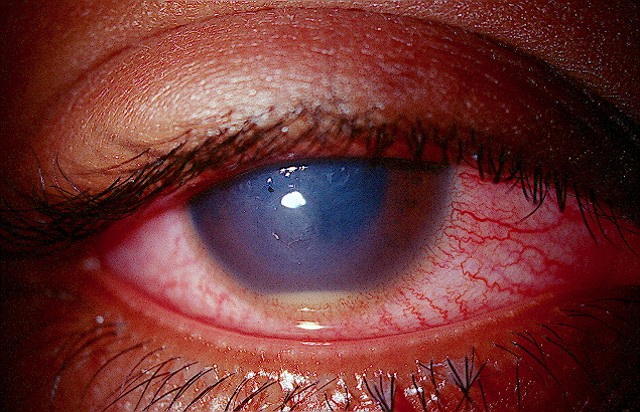 |
Patients with endophthalmitis in the upper and southern Midwest states are more likely to get prompt surgery than patients in the Northeast, study finds. Photo: Joseph Sowka, OD. Click image to enlarge. |
Tremendous effort has been spent trying to reduce the incidence of endophthalmitis as a postoperative complication. A recent analysis published in JAMA Ophthalmology used a US medical claims database with more than two decades of data to gauge how incidence rates have changed over time, as well as to evaluate the frequency and trend of prompt vitrectomy (vs. tap and inject procedures) as primary treatment of endophthalmitis. The findings showed that the rate of postprocedural endophthalmitis has decreased by almost 75% since the year 2000, and a similar reduction was noted in the rate of prompt vitrectomy as a primary treatment modality.1
The study, a collaboration between the University of Pennsylvania and Wills Eye Hospital in Philadelphia, created cohorts for different intraocular procedures, including intravitreal injections and surgeries for cataract removal, glaucoma, retinal conditions and corneal transplants, from 2000 to 2022. The data was sourced from a US administrative medical claims database that comprised commercial and Medicare Advantage insurance plans. Any intraocular procedure with at least six months of data (including from at least six weeks before and after the procedure) was eligible.
The researchers determined that the incidence of endophthalmitis declined from 0.2% in 2000 to 0.05% in 2022, and the rate of prompt vitrectomy decreased from 48.5% in 2003 to 11.7% in 2021. After controlling for other factors, the rate of prompt vitrectomy as a treatment for endophthalmitis also decreased by 3.8% per year over the whole period. Geographic location was also associated with prompt surgery since patients with endophthalmitis in both the upper and southern Midwest states were more likely to get the intervention than those living in the Northeast.
Surgeries involving glaucoma procedures conferred the highest risk for endophthalmitis in the analysis. The lowest rate of endophthalmitis across all procedures in their analysis was found after intravitreal injections. The total number of these injections increased significantly, representing approximately 0% and 6.7% of all procedures performed in 2002 and 2022, respectively. Additionally, the rate of post-injection endophthalmitis decreased from 1.45% in 2002 to 0.04% in 2022. The overall rate of post-cataract endophthalmitis was 0.08%.
“We found the type of procedure leading to the endophthalmitis was not associated with having prompt surgery, suggesting patients who had non-cataract procedures were just as likely to have prompt surgery as those undergoing other types of procedures,” the researchers wrote in their paper.1
A commentary also published in JAMA Ophthalmology noted that a key metric missing in the current analysis was whether endophthalmitis treatment outcomes have changed with lower use of prompt vitrectomy.2 The study concluded that additional work will need to be done to evaluate the reason behind this change in management and its clinical impact on outcomes.1
“There is a range of considerations that may impact the decision of whether to perform a vitreous tap or vitrectomy, including a patient’s medical comorbidities and associated anesthesia risks, visualization concerns in those eyes with corneal opacification and the availability of operative time, among others,” the commentary authors wrote. “It is interesting that the authors found that patients were less likely to receive a prompt vitrectomy in the Northeast US, where there is more population density and perhaps less immediate access to surgery.”
At their institution, the commentary authors believe that a cornerstone of endophthalmitis treatment should be early treatment with antibiotics, whether delivered with a vitreous tap or a vitrectomy.
“We favor vitrectomy for highly severe initial presentations, eyes not responsive to tap and injection or eyes with diagnostic uncertainty, but we realize that treatment should be tailored to each patient,” they emphasized.2
1. VanderBeek BL, Chen Y, Tomaiuolo M, et al. Endophthalmitis rates and types of treatments after intraocular procedures. JAMA Ophthalmol. Aug. 1, 2024. [Epub ahead of print]. 2. Ghalibafan S, Flynn HW, Yannuzzi NA. Changes in rates of postprocedural endophthalmitis and treatments. JAMA Ophthalmol. Aug. 1, 2024. [Epub ahead of print]. |


